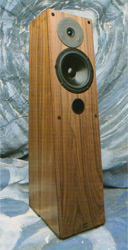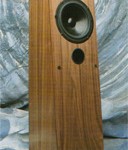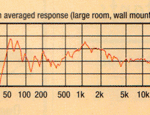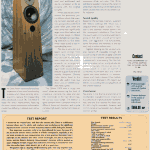Reproduced from “Hi-Fi Choice” published in May 1993.
Royd Abbot
The £666 Abbot is the smaller and less expensive of two new floorstanding models which Royd recently introduced to replace the longstanding Apex (reviewed In Issue 78). The Abbot Is really the direct replacement, featuring the same cabinet dimensions as the earlier model but differing in almost every other detail.
A scant few days before the last post sounded Royd informed us of some recent changes in the design. New samples were sent measured and auditioned and results correlated as far as possible with the original samples.
What used to be a transmission line enclosure (you can still see where the opening has been blocked up) is now a braced box with front panel reflex port, while the main driver has significantly larger cone than before and the whole design is riddled with intelligent and painstaking attention to fine detail which helps justify a not inconsiderable once.
The box is very slim and tapers quite strongly from base to top creating a pronounced slant for the baffle which helps aim the drivers upwards an arrangement which often assists in creating an ‘open’ sound and also ensures a good fore-and-aft stability footprint. Chunky metal blocks fixed to the base add useful mass low down and are drilled to accept hefty spikes.
The 20mm MDF box is nicely real wood veneered except on the back. A crossbrace connects the sides and also links mechanically
to the man driver magnet via two lossy bungs. The interior is lightly damped with a complex mixture of different fibres and densities, and a quite complex high quality hardwired crossover is used.The tightly bolted main driver uses a cast frame and heavy magnet to drive a 120mm doped paper cone, while a closely woven fabric covers the back of the unit to add acoustic resistance and control excessive driver excursion. The 19mm soft dome tweeter nestles at the centre of a thin foam disc several centimetres across, which should help absorb secondary baffle radiation.
Sound quality
Based on the samples originally supplied, the Abbot’s listening test result was a disappointment, largely I suspect in reaction to the distinctly uneven balance and the consequent colorations. Most found the sound quite communicative with plenty going on but rather uncouth at the same time with aggressive mid forwardness some terseness and hardness at the top end and a rather hollow bass.Sighted listening on the second samples started off enjoyably enough the sound having an attractive agility with fine dynamics and transient coherence that is fundamentally entertaining. But the balance anomalies remain, and gradually become increasingly intrusive as one becomes aware of a lack of warmth a somewhat inconsistent bass and a rather hyped and nasal midband. It’s sweeter, clearer and more coherent than before, and can match the best in this regard, but there’s no avoiding the consequences of the uneven balance.
Conclusion
Neutrality is not the be all and end all of loudspeaker evaluation by any means, but it is certainly an important factor nonetheless, and one that catches the Abbot out. It’s still a highly enjoyable, dynamic and communicative loudspeaker but a flawed one for all that.Verdict
+ Pretty package with a good sense of rhythm and drive.
– Uneven balance is the cause of significant coloration.
> £666.00 RRPTest Report
I measure the original pair, and then the current pair. There is a difference between them, but it’s subtle, and nowhere near as obvious as the significant departures from a neutral in-room frequency balance which both pairs showed.
How important neutrality really is has been debated for years. For some it’s the be-all and end-all; others consider it of little consequence, especially as the ear tends to make its own compensation after a little practice. And while I don’t subscribe to the ‘flatness uber alles’ school of thought, it’s still an important factor, and the Abbot’s distinctly ‘three-humped’ character with its peaked up upper midband and lack of upper bass and lower mid energy is certainly less even than the earlier Apex, which doesn’t get it off to a good start.
The positive side is a healthy 87dB sensitivity and very easy amplifier load, but tuning the reflex port to 48Hz means little serious bass output below 50Hz, even though this does optimally control the driver/box resonance.TEST RESULTS
Size (hxwxd): 83x20x31(max)cm
Weight: 15kg
Recommended amplifier power: 15-90W
Recommended placement: quite close to wall
In room averaged response limits 50Hz-10kHz: +/-7dB
Large room/space LF rolloff (-6dB ref midband): 43Hz
Large room/wall LF rolloff (-6dB off midband): 43Hz
Large room output at 20Hz (ref midband): below -16dB
Estimated midrange sensitivity (ref 2.83V, 1m): 88dB
Impedance characteristic (ease of drive): very good
Typical price per pair (Inc VAT): £666

Reprinted from, “Hi-Fi Choice” May 1993
 The £666 Abbot is the smaller and less expensive of two new floorstanding models which Royd recently introduced to replace the longstanding Apex (reviewed In Issue 78). The Abbot Is really the direct replacement, featuring the same cabinet dimensions as the earlier model but differing in almost every other detail.
The £666 Abbot is the smaller and less expensive of two new floorstanding models which Royd recently introduced to replace the longstanding Apex (reviewed In Issue 78). The Abbot Is really the direct replacement, featuring the same cabinet dimensions as the earlier model but differing in almost every other detail. 


